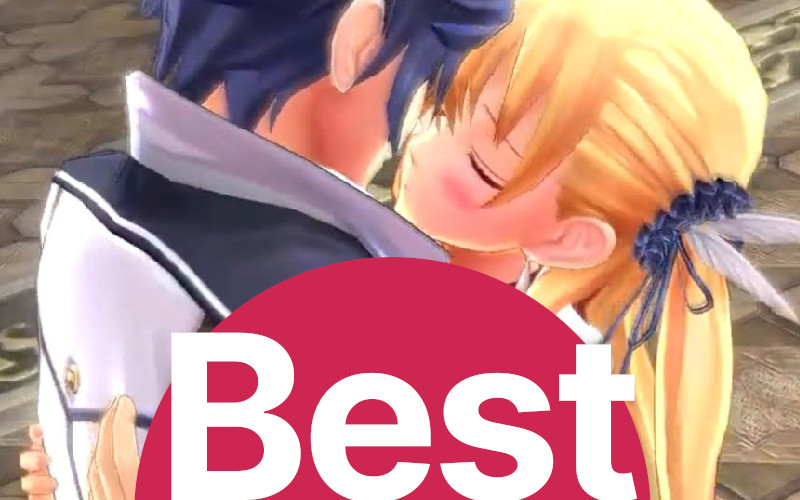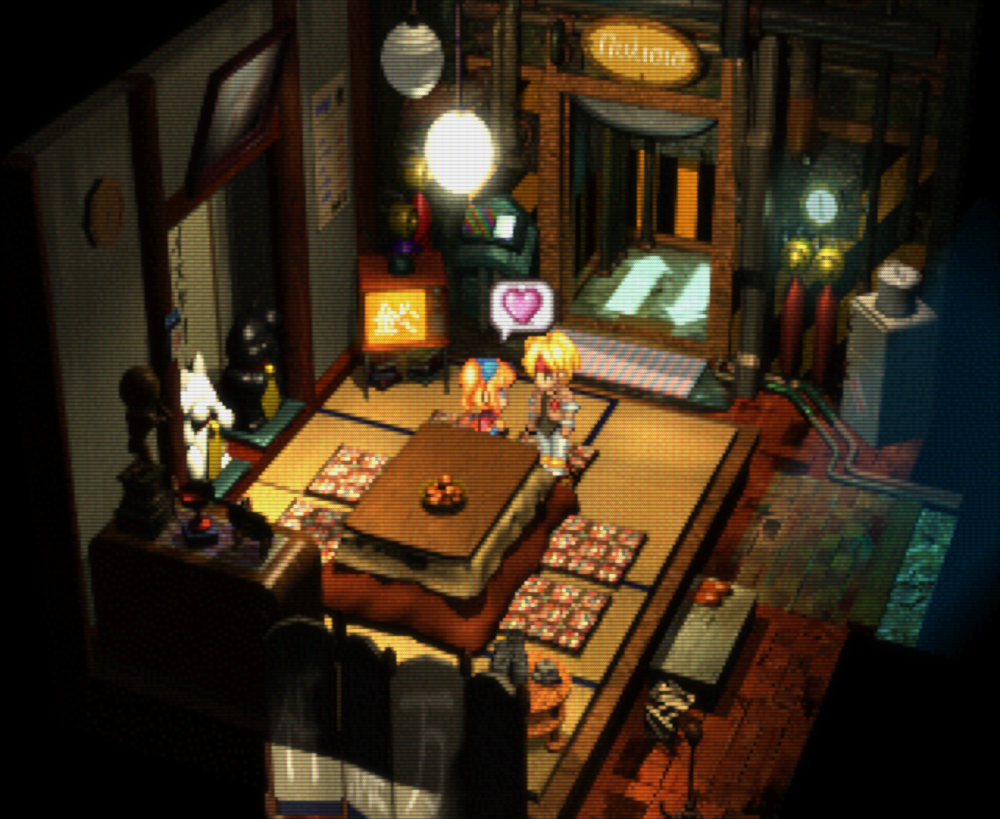You’re a globetrotter and a skilled fighter, on a quest to save the world with a team of brilliant men and women who are fast becoming your best friends. What would make this adventure even better? How about… falling in love?

Some of the best romances in videogames are from JRPGs. Cloud and Arieth. Tidus and Yuna. Pairings that inspired joy and jealousy as you watched the characters falling in love. But these couples do not appear in this article. It’s one thing to watch a romance story unfold, and another to play an active part in it!
When romance becomes a gameplay system, we want what we want in any gameplay system: interesting decisions. Yes, that includes a choice of which character to romance, but we also want to choose what to say to them, and whether we fight alongside them in battle. Decisions should also have consequences. If you court one character, that’s probably going to put off another character, or perhaps them jealous.
But this list is not just about gameplay mechanisms. Feelings play a big part too! The most interesting systems won’t impress us if the datable characters don’t make our hearts flutter. Sometimes a lack of complexity is made up for with, well… je ne sais quoi. That’s the case with the first game in the list.
Dragon Quest V (1992)

Here’s a story that demonstrates that lasting impact of the romance system in Dragon Quest V. Three full decades after the game was released in Japan, a shareholder of Square Enix asked the new president, Takashi Kiryu, a very important question at his first shareholders meeting:
I would like to know whether Director Kiryu chose Bianca or Nera.
Source
Bianca and Nera are the original two “Heavenly Brides” that could be married in Dragon Quest V (a third, Debora, was added in the Nintendo DS remake). Kiryu himself explained the differences in personality between the two: “Bianca is vivacious, whereas Flora is quiet.” Kiryu choose Bianca, but we can be sure his answer will not settle this debate, which has lasted over 30 years now.
What makes the heavenly brides worthy of note is that your choice of partner is also a choice of party member. Nera is more magically attuned; Bianca is better at hitting things with sharp objects. If you choose one, you cannot choose the other. It’s a simple system, but it has all the elements we’re looking for: the player has an active role in choosing to build a relationship with the women they vibe with the most, and this choice is reflected in the gameplay and the story. That the two brides were great enough characters to stand the test of time is a very nice bonus.

Enhancing Dragon Quest V‘s romance is a narrative arc that spans multiple generations, which, in typical Yuji Horii style, is equally inventive and compelling. The protagonist embarks on a quest that sees them grow from a child to an adult, experiencing various trials and tribulations along the way. Central to this journey are the relationships forged with a diverse cast of characters, including those potential love interests.
To this day, Dragon Quest V stands as a shining example of how romance can be integrated into JRPGs to enrich the player experience. It’s a great place to start the discussion, but the complexities of the romance systems take off from here.
Thousand Arms (1998)
Released during the late ’90s, this PlayStation cult classic is one part Breath of Fire, one part Tokimeki Memorial. The system it devised was the first of it’s kind, making Thousand Arms the prototypical JRPG/Dating-Sim hybrid, and still quite a good one.

At the core of Thousand Arms lies a dating sim mechanic that intertwines seamlessly with the traditional JRPG format. Players step into the shoes of Meis Triumph, a cheeky blacksmith with a penchant for both forging legendary weapons and capturing the hearts of various love interests. The game breaks away from the one-size-fits-all approach often seen in romantic subplots by allowing players to actively pursue relationships with different characters. These aren’t just aesthetic choices; each romantic path unveils unique storylines, character developments, and even specialised abilities that tie back into the main quest.
Decision-making takes centre stage in this romantic ballet. Meis must navigate through dialogue choices, gifts, and actions to woo the chosen companion. However, this isn’t a mere flirtation simulator – the consequences of these choices ripple through the fabric of the wider game. A successful romance isn’t just about personal satisfaction; it often means unlocking additional gameplay perks, offering a tantalising blend of emotional investment and strategic advantage.

Yet, the million-polygon question remains: does Thousand Arms pull off this romantic rendezvous with flair? For the most part, yes. The variety in romantic pursuits and the tangible impact on the overarching narrative are commendable. The game succeeds in making romance not just a side quest but an integral part of the gaming experience. However, some might find the system a tad formulaic, with certain decisions leading to predictable outcomes. Despite this, the game’s ability to blend heartfelt connections with tangible gameplay benefits ensures that the romantic journey in Thousand Arms is a worthy detour from the main quest – a detour that adds both depth and dimension to the JRPG experience.
Star Ocean 2 (1999)

Released in the late ’90s for the PlayStation, this space-faring epic not only took players on a cosmic journey but also allowed the player to navigate various romantic pairings. The Private Action (PA) system, which facilitates these romantic options in the Star Ocean series, is quite clever. It works like this: instead of entering a town as a party, you can always choose to enter the town alone, and your party members split off and do their own thing too, activating new dialogue options and events.
So “Private Actions” can be described like this: what do the protagonist and other party members get up to when the rest of the group aren’t looking? It’s no surprise that by the second game, Star Ocean: Second Story, Private Actions were used to explore romantic pairings between the characters. Claude can meet Celina at the shops and buy her a nice piece of jewellery, or meet Rena at the library and agree to become her tutor, and eventually the character you have the most affinity points for get a special moment with the protagonist in the game’s ending.
Affinity and choice of partner doesn’t affect the gameplay too much, but the system is undeniably praiseworthy. It goes beyond the typical ‘choose your sweetheart’ mechanic and weaves the romantic subplot seamlessly into the larger tapestry of the game. In doing so, Star Ocean 2 manages to offer a satisfying blend of emotional storytelling and player engagement.

A historical note: the developers of Star Ocean worked previously on the Tales series, and Private Actions fill a similar role to the skits of Tales, though with the player taking a more active role. We could also say Private Actions were a precursor to Social Links, the system that the next games on the list are known for.
Persona 3 (2006) and 4 (2008)
Developed by Atlus, these JRPGs are masterpieces of videogame romance systems. They manages to do it all: make the romance relevant to the monster-raising-dungeon-crawling mechanics at the core of the series, while also giving us heart-warming connections to nurture across a range of lovable characters.
Whichever of the Persona games you choose, the romance system is Social Link mechanic. As the protagonist navigates the towns of Tatsumi Port Island (in Persona 3) or Inaba (in Persona 4), they forge bonds with various characters, each represented by a distinct arcana.

For example, players can pursue a romantic relationship with Rise Kujikawa, a former idol who temporarily moves to Inaba. Players can support Rise as she grapples with her identity outside of the limelight, leading to a deeper emotional connection, which also levels up the arcana associated with Rise.
This makes you more powerful in battle. As you level up the Lovers arcana by romancing Rise, the monsters your fuse that are associated with the Lovers arcana get a flood of bonus experience. Brilliantly, social connections and romance become the pathway to unlock some of the most powerful monsters in the game.
Persona even tries to simulate break-ups. If you leave a lover in the cold for too long, or offend them, their social link will reverse. This happened to me when I accidentally ignored Yuko the sports captain in Persona 3, despite intending to complete her social link, after many hours of learning about her and winning her affection. I was genuinely shocked and upset! Thankfully, these reversed social links can be recovered.
What sets the romance in the Persona apart is the emphasis on character development. Yes, the social links are a linear checklist, but they’re also about delving deep into the psyche of each character and uncovering their vulnerabilities. When you add that to the advantage you get in battle as a result, it makes for one of the most addictive JRPG romance systems of all time. It’s easy to get totally lost in it!

